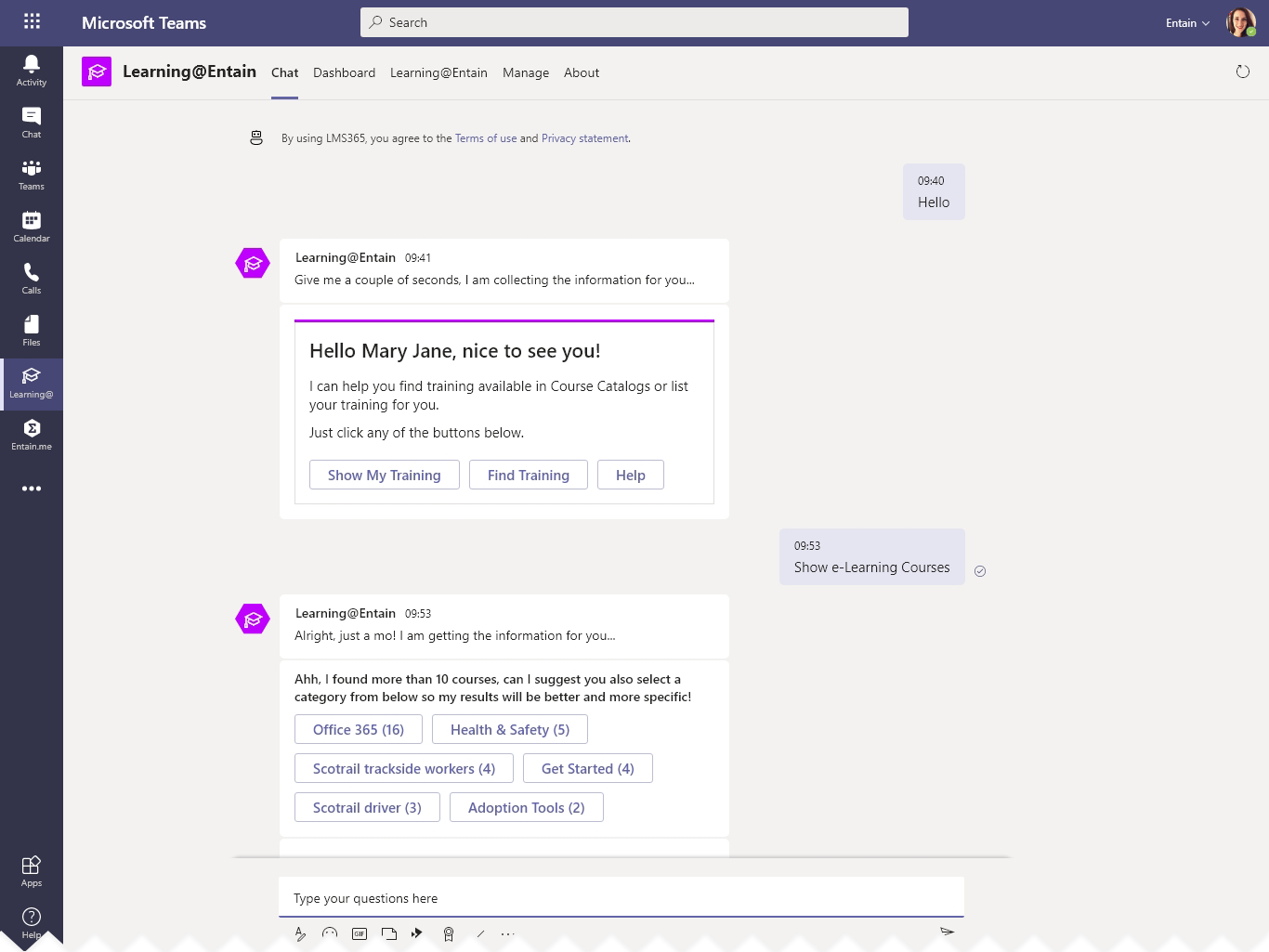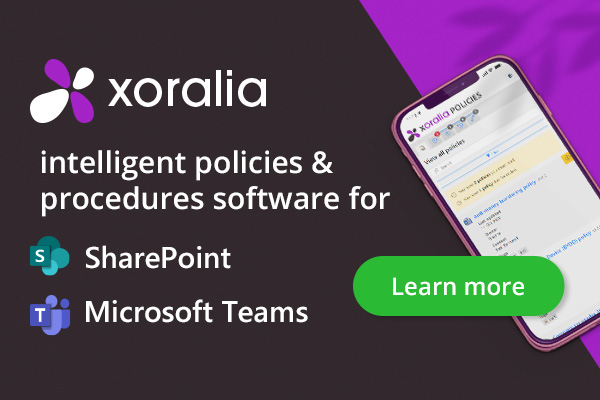For a long time learning was at the periphery of the digital workplace and away from the daily flow of work, for example centred on a Learning Management System that was not easy to access and had poor usability. Given the importance of learning and training to employees and organisations, this has always been an anomaly. Thankfully a range of digital tools mainly available through the Microsoft 365 digital workplace are at last integrating learning right into the heart of the digital workplace. With the current focus on employee experience and on enabling people to better use digital tools, there has also never been a better time to initiate a project to deliver better learning through Microsoft 365.
Another advantage of Microsoft 365 is that because of its wide variety of channels and tools, it can support different types of learning. Most organisations have blended learning programmes with a mix of classroom training, e-learning, mandatory training, mentoring, Communities of Practice and more. Microsoft 365 can support blending learning through a mix of different channels. It can also help learning administrators to manage learning and support managers who need to keep on top of the training within their teams.
In this post we’re going to explore the different tools and channels that can be used to support blended learning programmes, making learning more accessible and discoverable.

A core learning platform and LMS through LMS365
The most important part of a digital learning ecosystem is a core learning platform or Learning Management System (LMS) that allows users to access a course catalogue of training available, book courses, access course material, and carry out e-learning. They can also then view a record of the learning they’ve taken and what they might need to take in the future.
For administrators, a learning platform provides the core tools to manage learning, including an administration module, and extra features such as learning paths, certificates and points to deliver on the learning requirements of different organisations. There may also be tools to create learning content.
LMS365 is a fully featured learning platform that integrates seamlessly into Microsoft 365. It is an additional product to a 365 license and not provided by Microsoft, but many teams tell us it feels like part of the 365 suite, and it is gets excellent reviews. With LMS365 installed, it means most of the barriers associated with learning are removed and employees can reach and discover learning via different tools such as Microsoft Teams. In fact, the integration is so seamless that employees may not realise they have left SharePoint. There Is also a good LMS365 mobile app.
LMS355 is also very good at supporting blended learning, as you can manage both classroom training enrolment and e-learning from the same catalogue.
Learning hubs and pages through SharePoint
The flexibility of building SharePoint sites and pages means you can create dedicated learning hubs that guide users towards all the learning opportunities available for them, and then also include links, resources and even embed feeds for example from a Yammer learning community to make it easier for users to take action such as enrol on a course. Blended learning programmes cover a range of options, so a learning hub based on SharePoint provides both an overview and a starting point for employees.
Typically, a learning hub might be integrated into a SharePoint intranet, but it could also be a standalone communication site or even team site. Some LMS365 clients also choose to build a learning hub as a seamless entry page into LMS365. Some learning hubs may also be dedicated to specific topics for example learning about how to use digital workplace tools.
Learning discovery though Microsoft Search
A major advantage of bringing learning resources into your Microsoft 365 digital workplace is that it means you can include learning within your Microsoft search. Here the results of blended learning including specific courses, a community or even a specific learning asset can be returned, making learning more discoverable though an intranet, Teams and SharePoint search.
Automation and enrolment on learning through Power Automate
Learning is an area where automation can help streamline the administration of learning, for example in registering users on to different courses and updating learning records. A platform like LMS365 will do some of the automation for you and here the ability to leverage AD groups in Azure is particularly useful for example in rolling out mandatory training for all managers. Within 365, Power Automate can help you to create other automated and custom flows that can support blended learning; these might include automatic enrolment into a particular Community of Practice, or automated reminders for people attending a course.
Learning analytics through Power BI
Analytics are important not only in measuring the effectiveness of learning, but also in administering mandatory training. While some products within your learning ecosystem will include handy analytics built-in (such as our Xoralia Policy Management tool), integration with Power BI means it is very straightforward to create bespoke learning dashboards and reports for learning administrators, managers and even senior leaders.

Communities of Practice through Yammer or Teams
Communities of Practice (CoP) dedicated to professional topics are a solution that can support the less structured and more social elements of blended learning by providing access to experts within the community, facilitating interaction and discussions, and sharing learning resources such as videos. The best tool to use for a CoP is Yammer particularly if a community is large – but it is also possible to use Teams, particularly if the community is a smaller and more focused.
Policies and mandatory reads through Xoralia
A blended learning programme and also the learning elements of an employee onboarding programme may require employees to read particular policies and documents. Here the mandatory reads capability within a tool like Xoralia can help keep track of which employees have read a page or document; the tool lets employees know they have something to read, asks for confirmation they have read it and then delivers reports to administrators to track progress. Xoralia is built for SharePoint so again integrates seamlessly with other 365 tools.
Learning events calendar via SharePoint or LiveTiles intranet
Blended learning programmes are likely to include learning events such as webinars. A central calendar of learning events can also be a good way to display upcoming opportunities for employees, particularly if it is available via the intranet. This can be achieved in different ways including using SharePoint calendars or using the event calendar functionality within a LiveTiles intranet. At Content Formula client RSSB, the latter is used to display learning events on the intranet homepage.
Frontline enablement through PowerApps, LiveTiles Reach or LMS365 app
Learning is also an important component in enabling frontline employees and delivering a good employee experience. Being able to access learning materials including training videos on a personal device is an excellent way to support wider learning, especially when it can be carried out a time convenient for that user. A variety of different options across Microsoft 365 can deliver learning to the frontline via mobile apps including custom PowerApps, LiveTiles Reach or the LMS365 app.
Social learning through LMS365 for Teams and Microsoft Viva Learning
More informal social learning and sharing is another component of blended learning. With Microsoft Teams usage so high, making sure employees can access learning through Teams and then have conversations about learning opportunities and resources can support blending learning. Here, LMS365 for Teams can make learning discoverable and allow peers to share learning resources within their discussion thread. Microsoft Viva Learning is also bringing learning into Teams, although this offering is still evolving, but we can expect this to play a major role going forward.
Blended learning through the digital workplace
Microsoft 365 provides excellent support for blended learning from LMS365 as a core learning platform through to Yammer-based Communities of Practice through to Power BI learning dashboards.
If you’d like to discuss how to support learning in your organisation and make sure it is in the flow of daily work, then get in touch!

